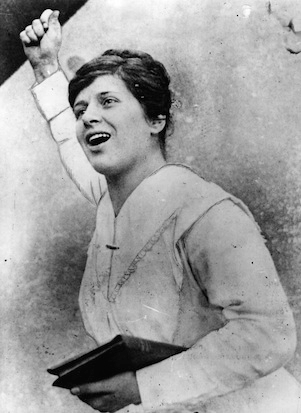She was the sequinned star of the airwaves back in the 1920s, the first preacher to realise the potential of the wireless, long before Billy Graham and co. But who now has heard of Aimee Semple McPherson, the radio evangelist? Born in 1890 and raised on a farm in Canada, she was converted as a teenager by a Pentecostal preacher whom she married and joined on his missionary travels. When he died she took up preaching herself, moving to Hollywood and becoming enormously popular as a great healer of the sick and saviour of souls, dressed up for the part in a long white figure-hugging gown adorned with a huge glittering cross. Naomi Grimley told her story for the World Service’s The Documentary.
Sister Aimee had a huge temple built in Echo Park, designed on the outside like a white wedding cake with a huge neon cross on top. Inside she created not a church but a theatre with three levels, balconies, an orchestra pit and a stage. But that wasn’t enough for Sister Aimee. She may have been in Hollywood, home of the movies, where she could hire its designers to help her create each week a dramatised version of Moses on the Mountain or Noah in his Ark. But she also understood the power of radio, of the bond created between unseen speaker and listener at home. On top of her theatre were two radio masts, beaming her words into the homes of millions of Californians.
At the height of her fame, though, on 18 May 1926, Sister Aimee disappeared from the beach where she was last seen going for a swim, only to reappear as if by magic five weeks later. The newspapers, sensing a scandal, slaughtered the reputation of this bright, glamorous woman who had made her fortune and taken religion out of the church and into the home. She claimed to have been kidnapped and kept hostage in Mexico, but the press accused her of having an affair with her radio engineer. Was she a charlatan or a Christian pioneer? Grimley left us to make up our own minds in this classic feature (produced by Nick White, with just enough, but not too much background sound).
Sister Aimee sounded just like Monroe as she flirted with the microphone, inviting her listeners to share with her the troubles of life and to put themselves in the hands of God. But how sincere was she? Was she just play-acting? If the actor Samuel West is to be believed we should have been able to work this out by hearing her voice on air. ‘Insincere people have insincere voices. You can tell because they sound so sincere,’ he told us on The Essay on Radio 3 (produced by Tim Dee), which this week has been looking at what makes a good radio voice and why.
You can’t disguise on radio. There’s nowhere to hide. Just listen to an afternoon play where the actors are reading the words, not really believing them. Straight away the connection with the listener is lost. There is nothing to hold you; nothing to prevent you from switching off. ‘The big no-no,’ says West, ‘is trying to feel.’
The great journalist and broadcaster Olivia O’Leary echoed his enthusiasm. ‘The radio voice talks to you and tells you stories that you’ll never forget’, she said, reminding us of that moment when Gordon Wilson talked about his daughter Marie who had died in the IRA bomb attack on Enniskillen. ‘The pain in that man’s voice,’ once heard, will never leave you. Such interviews can have an extraordinary effect, Wilson touching millions with the rawness of his grief. But to have seen that pain etched on his face would have lessened its impact. The voice carries with it dimensions of feeling untouched by mere pictures.
Fi Glover, reminded us, though, on Friday that the sheer power of the connection, the alchemy of radio, has its dangerous side. In the Rwandan civil war, for instance, the national radio station was used by the Hutus to encourage violence against the Tutsis. ‘The graves are not yet full,’ said the announcer, urging his listeners to phone up the station and get the names and addresses of Tutsis they could then go out and massacre. Hate radio still exists and earlier this year played a role in the massacre in Bentiu, South Sudan, where men were encouraged by the local FM station to go out and rape, torture and kill their Dinka rivals.
Will radio, though, survive the era of tweeting and texting? That focus on just one voice is totally alien to a generation brought up to look, listen, text and type all at the same time. They demand pictures. Glover is optimistic. She reckons that in time radio’s perfect consumer credentials — the mystery of hearing a disembodied voice speaking directly and only to you, without you having to do anything, and which can be heard while you’re on the move, in the kitchen, on the loo or under the duvet — will win through.






Comments